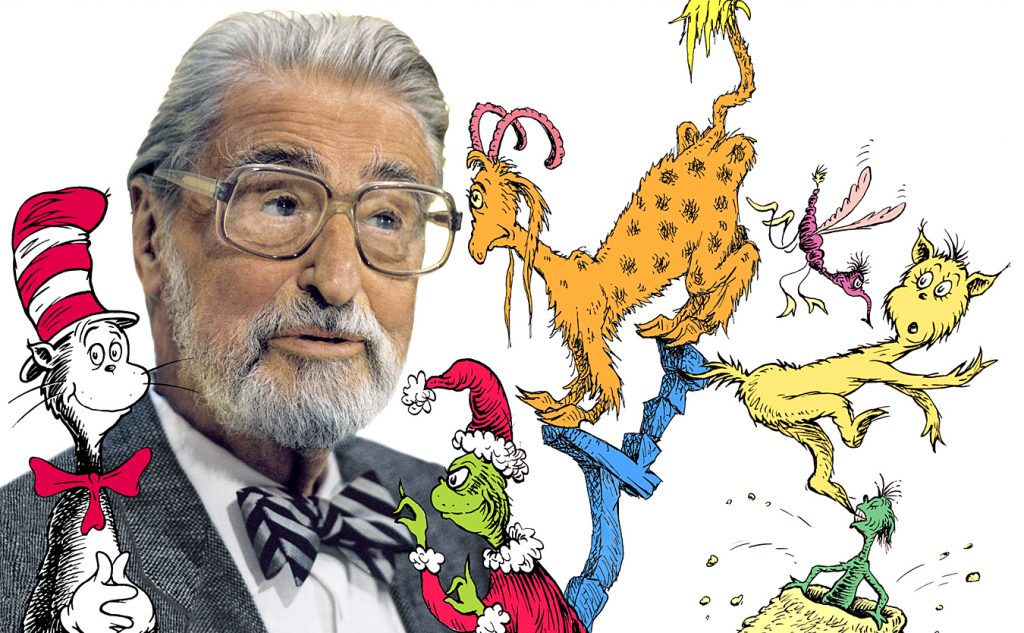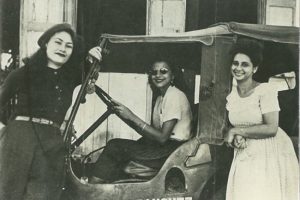Theodor Geisel, beloved children’s author, had a life before he put the hat on the cat. Born March 2, 1904, in Springfield, Massachusetts, Geisel was the only son of German-born immigrants. He spent a normal childhood with his sister and parents, before going to college to become a teacher. Geisel dropped out of college shortly before completing his doctorate in literature. He would eventually turn his almost doctorate and his mother’s maiden name into his now famous pen name, Dr. Seuss.1

In 1927, Geisel decided to turn his passion for drawing and writing into a career in advertising. One of his early successes in advertising was his drawing for Flit insecticide, whose mascot looked very similar to the cat that would eventually wear a striped hat.2 He later created an entire campaign for Essomarine Oil, a division of Standard Oil, called Seuss Navy, in which he designed certificates of membership, pamphlets, and even ashtrays and cocktail glasses that were passed out at trade shows. The Seuss Navy ads ran from 1936 to 1941, and contained many of the sea creatures that would later appear in his books.3 Geisel used many of his made up creatures in various ad campaigns and was the first person to use humor to sell products, altering the advertising industry.4

In 1941, Geisel left advertising to work as a political cartoonist for liberal New York newspaper PM. He drew over 4oo cartoons targeting such topics as isolationism, antisemitism, and racism. He routinely mocked Hitler and Mussolini, but he had a particular flair for attacking American nationalism as well. Believing that the American Nationalist Movement was just another form of fascism, Geisel made Charles Lindbergh a frequent subject of his cartoons.5 After the Japanese attack on Pearl Harbor, Geisel began to use his cartoons to support the war against Japan. He drew cartoons that “depicted Hideki Tojo, the Prime Minister and Supreme Military Leader of Japan, as an ugly stereotype, with squinting eyes and a sneering grin.”6 Geisel was in support of Japanese internment camps and drew several cartoons about them.

It can be hard to imagine that Dr. Seuss could be a racist in his depiction of Asians, but he later admitted that this was exactly the case. At the time, PM did not receive one letter of complaint about Geisel’s stereotypical depiction of Asians, although they received many letters when Geisel mocked the German dachshund, which was popular among American dog owners. Dr. Seuss later said that his 1954 book, “Horton Hears a Who,” written after a trip to Japan and dedicated to a Japanese friend, is meant to be an apology to the Japanese people for his depictions of them during World War II. In the 1980’s, Geisel looked through all his children’s books and removed anything he felt was racist, changing them for any future publication.7
Geisel’s political cartoons ended when he joined the Army in 1943. The now Captain Geisel was assigned to a unit that made training films for the Army, working with the likes of Stan Lee (creator of super heroes) and Chuck Jones (creator of the Road Runner and Wile E. Coyote).8 Geisel and Jones would become life long friends and would work together on various projects, including the animated “How the Grinch Stole Christmas,” which is still shown every year on television.

Geisel’s first children’s book was “And to Think I Saw It on Mulberry Street,” and was published in 1937. However, his writing career almost never happened. The book had been turned down by 27 publishers and Geisel was ready to give up the idea of becoming a children’s author when he ran into an old college friend while walking down the street. His friend had recently become an editor at Vanguard Press and asked Geisel to send him the book so he could show his boss. Geisel would later say in interviews that it was pure luck that he walked down that side of the street that day.9
Dr. Seuss later claimed that he did not like to write books that had a moral or ethical lesson, because children could see a lesson coming and would not want to read the book.10 However, all of Geisel’s books, except his Beginner Books, contained lessons of some sort. Dr. Seuss wrote books with lessons on environmentalism, racial equality, the pointlessness of the arms race, materialism, and respect, just to name a few. He was one of the first children’s authors to write books for children with the respect and care typically reserved for adult literature.11
Dr. Seuss died on September 24, 1991 at his home. He was asked shortly before he passed away to leave a message for children. He wrote “The best slogan I can think of to leave the kids of the U.S.A. would be ‘We can…and we’ve got to…do better than this.’ He then crossed out ‘the kids of.'”12 Dr. Seuss left a legacy of children’s literature that will not soon be forgotten, but he did more than that; Dr. Seuss taught children to think.
- Janet Schulman and Cathy Goldsmith, Your Favorite Seuss (New York: Random House, 2004), 6. ↵
- Louis Menand, “Cat People,” The New Yorker (December 2002). ↵
- Janet Schulman and Cathy Goldsmith, Your Favorite Seuss (New York: Random House, 2004), 55. ↵
- Janet Schulman and Cathy Goldsmith, Your Favorite Seuss (New York: Random House, 2004), 117. ↵
- Sophie Gilbert, “The Complicated Relevance of Dr. Seuss’s Political Cartoons,” The Atlantic (January 2017). ↵
- Sophie Gilbert, “The Complicated Relevance of Dr. Seuss’s Political Cartoons,” The Atlantic (January 2017). ↵
- Sophie Gilbert, “The Complicated Relevance of Dr. Seuss’s Political Cartoons,” The Atlantic (January 2017). ↵
- Janet Schulman and Cathy Goldsmith, Your Favorite Seuss (New York: Random House, 2004), 9. ↵
- Louis Menand, “Cat People,” The New Yorker (December 2002). ↵
- Janet Schulman and Cathy Goldsmith, Your Favorite Seuss (New York: Random House, 2004), 190. ↵
- Janet Schulman and Cathy Goldsmith, Your Favorite Seuss (New York: Random House, 2004), 84. ↵
- Janet Schulman and Cathy Goldsmith, Your Favorite Seuss (New York: Random House, 2004), 190. ↵



125 comments
Eric Ortega Rodriguez
Wow, this is a very fascinating article. Primarily because it gives us an insight of who Dr. Seuss really was. I found it bizarre that Theodor Geisel would create political cartoons that depicted the Japanese in such a stereotypical way. I find it crazy that he went from doing cartoons that supported the war against Japan and Japanese internment camps. Overall, this article was very well written with an original topic selection.
Gabriela Ochoa
Reading his books as a kid I would have never thought that they were intended to teach a lesson is someway. I read that he worked in ads and did political cartoons was new to me and interesting. I would have never imagined him doing those types of things or having the views stated in the article. His books were amazing and continue to be for kids who still read them and will continue too, and he will continue to be appreciated for his work and laughs he brought.
Lilliana Canales
I would have expected Giesel to get in trouble for his political cartoons being during the time of WWII but that was a surprise to read nothing of it. I had no idea Horton hears a who was about a visit to Japan and an apology, I always enjoyed it was a cute elephant finding a speck and discovering a town there but now thinking about it, maybe Giesel saw Japan as nothing more than just a small irrelevant piece of this Earth until learning that the Japanese are people with feelings just like himself. This article was interesting and it would be fun to teach young children about a beloved man who was a racist.
Brianna Ford
I absolutely love reading Dr. Seuss’s books, especially when I was a growing up. I use to remember how we would celebrate “Dr. Seuss Day” in elementary and spent all day doing activities that pertained to his books. I honestly don’t know how he came up with such amazing rhymes, his books show that he was a kid at heart. This article did a very good job at painting Dr. Seuss’s life in a different way that I am sure not many people knew of. He is a well respected man today and he was one of the highlights of my childhood.
Caden Floyd
Almost everyone knows of or has read at least one of Dr. Seuss’s books. I personally grew up listening to them and reading them. I had never really wondered how he came up with such strange things or how he even came to be the famous Dr. Seuss in the first place. This article really opened a door allowing us to look into his life and better understand him. I think it is really cool how he started out drawing political cartoons and advertisements.
Sebastian Carnero
I normally don’t go too in-depth about the authors of the books I read. Doctor Seuss’ story is what’s made that change. I am really surprised by the use of his early work has. I had no idea he used to make anti-nazi or racist political advertising. It is really interesting that the books he made for children could even teach something valuable to adults, his books had great quality and they make me remember great moments. The message he left before passing away is sad, but it is still valuable. We can always do better.
Andrea Cabrera
His books were an essential part of my childhood and shaped most important children’s books that we know. I’m one of his biggest fans and I’ve always wanted to know more about his beginnings. It is always beautiful to find out how people turned their hobbies to their workplace. I was not surprising he started as an advertisement artist, but it was amusing to know he also did war propaganda.
Faten Al Shaibi
It is a strange life march where he started from a designer of Advertisements , to a political cartoonist to finally turn from the life of politics to the life of innocence.
His books are among the most important children’s books that are read in schools.
I heard a lot about Dr. Seuss but this is the first time I know about his beginnings and his previous life before he wrote his books for children.
It is nice to turn a person’s hobby into a source of success and actually if a person likes his work he will succeeded in it.
Jorge Martinez
The ending had me in chills. This was a great read, no doubt. I do remember analyzing an political cartoon by Geisel during the second world war. If I remember correctly, the piece was satiric on the Americans ignoring the cries of the Jews for help. I also love how we can see some of Geisel’s famous characters in the 1942 cartoon.
Kailan Pena
I love Dr. Seuss so much, so I love an article or read about him as well. I had known that Dr. Seuss was an artist for propaganda and advertisement before his career as a children’s book writer, but I didn’t know he also drew for the Army alongside Stan Lee! That’s so amazing and impressive, I applaud artists that do so much with their talents like Dr. Seuss did.